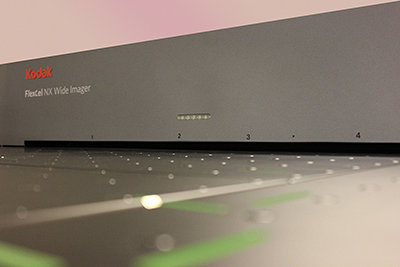Digital Prepress | Bridging the Gap Between Flexo and Offset
- Published: March 31, 2014, By Nsenga Byrd Thompson
Precision Color Graphics (PCG) prides itself on taking the prepress road less travelled. With its 25,000-sq-ft facility in Franklin, WI, the 21-year old prepress veteran has built its prepress and plating service—once dedicated to lithographic and screen printing—into a company that offers customers value-added products and services in flexographic printing and the flexible packaging market.
As PCG diversified over the years, the company recognized a sizable gap in what it could do with graphics and high-end reproduction in flexo versus what it had done in the past with offset lithography.
Scott Burns, account executive at PCG, says that was one of the biggest challenges in bridging the gap. “The color gamut was so narrow, we couldn’t get those fine highlight dots and couldn’t reproduce a lot of colors out of four-color process,” he says, adding that ink density was another major issue they faced with flexo. “Press operators were over impressing their plates to try to get more density and to get a three percent dot to print well,” says Burns. “In the process of doing that, operators were shortening plate life and reruns.”
The Flexo Plate “Game Changer”
With the major challenges that flexo printing still needed to address, PCG found that Kodak’s FLEXCEL NX Wide System and FLEXCEL NX plates offered a viable solution not evident in other flexo technologies. Kodak describes its FLEXCEL NX system as a complete solution for digital platemaking that enables converters to push the boundaries of flexography by printing smoother, higher-density solids without laying down more ink and reducing the number of colors per job without sacrificing print quality.
“When we saw the specifications on Kodak, they were earth-shattering because they addressed all of the issues that we had with flexo printing and plating,” says Burns.

Before Kodak emerged with its NX technology, PCG couldn’t get a one, two, or three percent dot on a flexo plate, which limited what the company could do in terms of the colors they reproduced and in handling fine blends and highlight areas. “Kodak fixed that by upping the ante with the dpi available in reproduction,” says Burns. “That made us take a look at it and say, ‘This is it—this is a game changer.’”
The NX plate’s flat surface and DigiCap screening technology allow ink to be more evenly distributed, resulting in increased solid density and reduced dot gain, extending the life of the plate. The dots are imaged onto the FLEXCEL NX Thermal Imaging Layer, which is laminated to the NX plate. This eliminates all oxygen between the layer and the plate, allowing stable, flat top dots to form and enabling PCG to get 1:1 dot reproduction onto the plate.
“DigiCap is a texture pattern that we image across the entire imaged area of the plate, including the surface of every dot or solid on the plate. Pattern elements are only five-by-ten microns in size and are distributed evenly on the surface of the plate, so we can carry our inks better,” says Burns. “The difference in how the plate handles the ink is so dramatic, we are seeing huge gains in density and unbelievable clarity and detail.
“We are able to introduce a no-oxygen environment,” explains Burns. “We get absolute straight up and down dots…so we can get that one percent dot that we couldn’t get before.”
With these features alone, Burns says PCG was sold on Kodak’s NX technology. But it’s the capability of imaging at 10,000 dpi, compared to traditional plates imaging at 2,400 dpi and HD plates imaging at 4,800 dpi, which has been its most impressive feature.
“That’s the reason why we can get half-point type and why we can get a five-by-ten micron hold at the top of a plate,” he says. “We are imaging at four times the dpi of the average plate.”
When talking to clients about the advantages of NX plates, Burns says that he is regularly met with great scepticism, but showing the plate’s capabilities in action is always proof of its revolutionary capabilities. Go and download 1700+ siterips if you have good internet connection
“I haven’t been at a meeting where the pressroom guys weren’t standing there saying, “Wait a minute; this doesn’t happen.’ But they are watching it happen right in front of them.”
Burns contends it is true testament that the gap between offset and flexo is finally closing.
For more about Precision Color Graphics’ history and growth in the flexible packaging industry, check out the June 2013 article, “Precision Color Graphics Breaks Course.”




